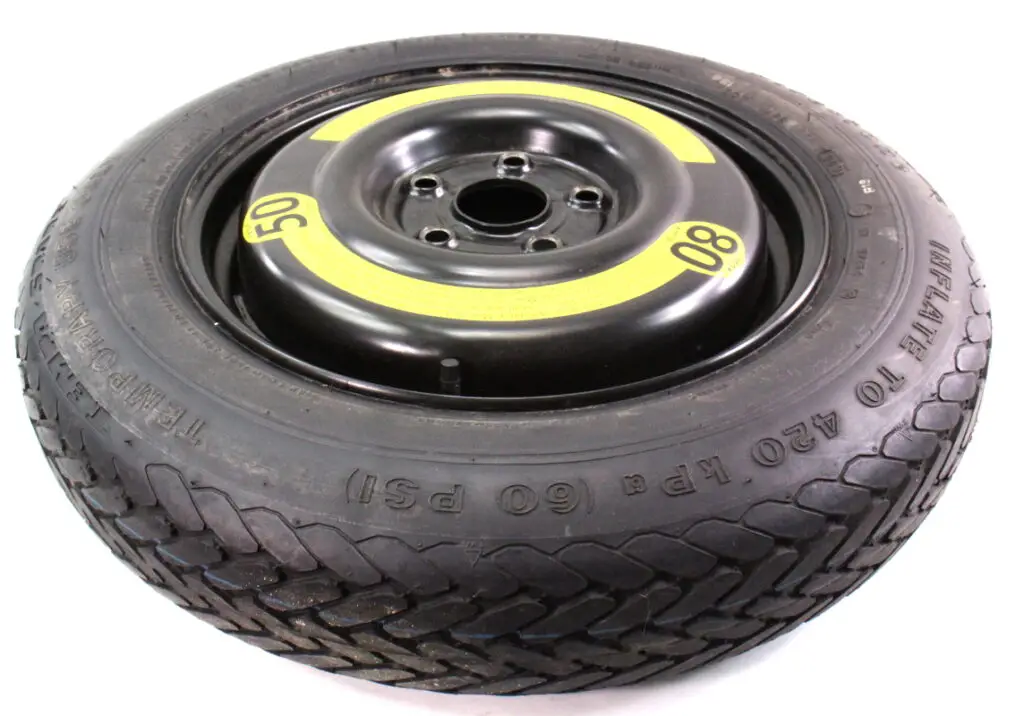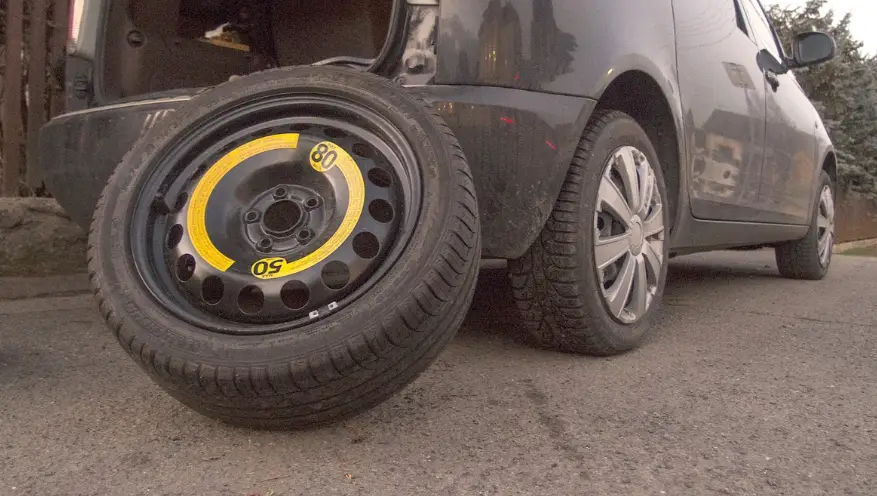Can you put a donut on the front tire? It’s not recommended, as it can affect handling and damage the drivetrain, especially on front-wheel-drive vehicles. It’s safer to place the donut on the rear tire.
The donut spare tire is a familiar emergency tool found in many vehicles. When faced with a flat tire, many drivers wonder if it’s okay to use the donut spare tire on the front tires of their vehicle. The decision might seem simple at first, but it’s essential to consider several factors, including the type of vehicle, the wheel drive configuration, and the limitations of the spare tire itself.
This comprehensive guide will answer all your questions about using a donut on the front tire. We will explore the potential risks, provide best practices for using a donut tire, and explain whether or not it’s safe to use a donut spare on the front tire of the vehicle.

Contents
What is a Donut Spare Tire?
A donut spare is a smaller, compact tire designed for emergency use only. It’s often referred to as a “temporary” spare because it’s not intended to be driven on for long distances. These tires are typically smaller in diameter and width compared to the regular tires on the vehicle, which helps save space in the trunk or undercarriage.
Pros and Cons of Donut Tires
Donut tires provide a temporary solution in case of an emergency, their limitations and potential risks should not be overlooked.
Advantages:
- Space Saving: Donut spares are small and easy to store, which is why they’re commonly included in vehicles as a temporary emergency solution.
- Lightweight: Their light design makes it easier to handle when you’re swapping out a flat tire, especially for people who aren’t used to working with full-sized tires.
- Affordability: Donut spares are less expensive than regular tires, so manufacturers often include them in the vehicle’s kit.
Disadvantages:
- Limited Performance: These tires are not built to handle the same loads, speeds, or distances as regular tires. They are designed for temporary use only.
- Reduced Durability: Due to the smaller size and limited tread, donut spares wear out much faster than regular tires.
- Safety Concerns: The small size and different specifications can lead to instability, particularly when used on the front tires of certain vehicles.
Can You Put a Donut on the Front Tire?
While it might be tempting to use the donut spare on the front tire, this decision requires careful consideration. Here’s a breakdown of the key factors that influence whether it’s safe to use a donut on the front tires:
1. Vehicle Type Matters
The safety and functionality of placing a donut on the front tire largely depend on the type of vehicle you drive. Whether a car is a front-wheel-drive (FWD), rear-wheel-drive (RWD), or all-wheel-drive (AWD) vehicle will significantly impact the decision.
- Front-Wheel Drive (FWD): The front tires of a front-wheel-drive car are responsible for both steering and propelling the vehicle forward. This makes it risky to place a donut on the front tire because the smaller size could lead to handling instability, uneven wear, and potential damage to the drivetrain. In FWD vehicles, it’s generally advised to place the donut on the rear tires.
- Rear-Wheel Drive (RWD): If you have a rear-wheel-drive car, it is typically safer to place the donut on the rear axle. Since the rear tires are not involved in steering, this reduces the risk of unstable handling. However, even with rear-wheel-drive, the donut is only a temporary fix and should be replaced as soon as possible.
- All-Wheel Drive (AWD) and Four-Wheel Drive (4WD): AWD and 4WD vehicles are especially sensitive to changes in tire size, as the drivetrain relies on uniformity between all tires. Using a donut on any tire can strain the drivetrain and cause long-term damage. For these vehicles, it’s best to avoid using a donut on either the front or rear tire and instead use a full-sized tire or call for roadside assistance.
2. Manufacturer Recommendations
One of the best ways to determine whether it’s safe to put a donut spare on the front tire is by consulting the vehicle’s owner’s manual. Many manufacturers provide specific guidelines on how to use the spare tire and where it should be placed.
For example, manufacturers like Subaru, Honda, and BMW generally recommend placing the donut spare on the rear axle, even for front-wheel-drive vehicles. This recommendation is made to avoid issues with handling and to prevent potential damage to the differential or other critical parts of the drivetrain.
3. Risks of Using a Donut on the Front Tire
While donuts are designed for short-term use, there are several risks to consider when using them on the front tire:
- Handling Instability: Because the donut is smaller and thinner than a regular tire, it can affect the car’s handling. With the donut on the front, this can lead to unpredictable steering and difficulty in maneuvering, especially at higher speeds or during sharp turns.
- Differential Damage: The difference in tire size between the donut and the regular tires can lead to uneven rotation speeds, which can put stress on the differential. This can cause significant damage to the drivetrain, especially in vehicles with all-wheel-drive or front-wheel-drive configurations.
- Braking Performance: The donut spare typically has less tread depth than a standard tire, which reduces its ability to grip the road. This can lead to longer stopping distances, especially in wet or slippery conditions, compromising the safety.
Best Practices for Using a Donut Spare Tire
If you find yourself needing to use a donut spare on the front tire, follow these best practices to minimize risks and ensure your safety:
1. Limit Speed and Distance
Donut spares are not designed for high-speed driving. Most experts recommend not driving faster than 50 mph (80 km/h) and limiting the driving distance to 50-70 miles. This ensures the tire doesn’t overheat and reduces the strain on the drivetrain.
2. Avoid Highways and Busy Roads
Whenever possible, avoid driving on highways or busy roads with a donut spare on the front tire. Stick to local roads where you can drive at slower speeds, reducing the risk of an accident.
3. Regularly Check Tire Pressure
Before using a donut, make sure it is properly inflated. An under-inflated donut can be even more dangerous, increasing the risk of a blowout or other tire-related issues. Check the tire pressure regularly to ensure it is within the recommended range.
4. Replace the Donut Tire ASAP
A donut spare is a temporary solution. It’s critical to replace it with a full-sized tire as soon as possible to ensure that the vehicle is safe to drive long-term. Prolonged use of a donut tire can result in more significant damage to the vehicle.

Frequently Asked Questions
Here are some FAQs about using a donut on the front tire –
1: Can I use a donut spare on the front tire of my front-wheel-drive car?
It’s generally not recommended to use a donut on the front tire of a front-wheel-drive car. The front tires are responsible for steering and propelling the vehicle, and the smaller size of the donut can affect handling and lead to differential damage.
2: How far can I drive on a donut spare?
Most experts advise that you limit your driving distance to 50-70 miles and avoid driving at speeds higher than 50 mph when using a donut spare.
3: Can I put a donut on an all-wheel-drive vehicle?
It is not advisable to use a donut spare on an all-wheel-drive vehicle, as it can cause strain on the drivetrain and lead to mechanical issues.
4: What should I do if I have a flat tire and no spare?
A4: If you don’t have a spare, you can use a tire repair kit or call roadside assistance for help.
Q5: Can I use a donut spare on the rear tires?
A5: In most cases, it is safer to use a donut spare on the rear tires, especially for rear-wheel-drive vehicles, as the rear tires are not responsible for steering.
Conclusion
When facing a flat tire, the question of whether or not to put a donut on the front tire is one that should not be taken lightly. Although a donut spare can temporarily get you back on the road, it comes with certain risks—particularly when used on the front tires. Always consult the vehicle’s manual, follow best practices for usage, and remember that a donut spare is only a short-term solution. For the safety, replace it with a full-sized tire as soon as possible.